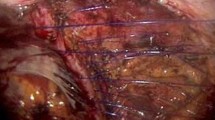Abstract
Introduction
Flank hernias represent a challenging problem to reconstructive surgeons. Their anatomic proximity to the bony prominence and major neurovascular structures limits fixation options and restricts mesh overlap. We present our technique and outcomes of a preperitoneal repair with wide mesh overlap.
Methods
This study is a retrospective analysis of patients undergoing open flank hernia repair with a retromuscular preperitoneal approach.
Results
Between September 2007 and April 2011, 16 patients, mean age 55 years (range 34–80) and BMI 33 kg/m2 (range 26–46), underwent open flank hernia repair. Eight were recurrent hernias; six previously had mesh placed; nine were incarcerated. Mean hernia defect size was 232 cm2 (range 25–800). Mean operative time was 178 min (range 105–245). One intraoperative complication, ureteral injury in a transplant recipient, occurred and was primarily repaired without sequela. Two patients developed wound complications, one requiring superficial debridement and another requiring partial excision (<5 %) of the mesh with secondary healing. With a mean follow-up of 16.8 months (range 2–49), no recurrent hernias were noted.
Conclusion
Open retromuscular preperitoneal repair of flank hernias with iliac bone fixation is technically feasible, allowing wide mesh overlap for a durable repair. This approach may offer advantages of treating abdominal wall laxity and repair of larger defects when compared to laparoscopic approaches.




Similar content being viewed by others
References
Heniford BT, Iannitti DA, Gagner M (1997) Laparoscopic inferior and superior lumbar hernia repair. Arch Surg 132:1141–1144
Esposito TJ, Fedorak I (1994) Traumatic lumbar hernia: case report and literature review. J Trauma 37:123–126
Stamatiou D, Skandalakis JE, Skandalakis LJ, Mirilas P (2009) Lumbar hernia: surgical anatomy, embryology, and technique of repair. Am Surg 75:202–207
Arca MJ, Heniford BT, Pokorny R, Wilson MA, Mayes J, Gagner M (1998) Laparoscopic repair of lumbar hernias. J Am Coll Surg 187:147–152
Bolkier M, Moskovitz B, Ginesin Y, Levin DR (1991) An operation for incisional lumbar hernia. Eur Urol 20:52–53
Cavallaro G, Sadighi A, Miceli M, Burza A, Carbone G, Cavallaro A (2007) Primary lumbar hernia repair: the open approach. Eur Surg Res 39:88–92
Geis W, Hodakowski G (1995) Lumbar hernia. In: LM Nyhus, RE Condon (eds) Hernia, Lipincott, Philadelphia, pp 412–424
Sutherland RS, Gerow RR (1995) Hernia after dorsal incision into lumbar region: a case report and review of pathogenesis and treatment. J Urol 153:382–384
Zieren J, Menenakos C, Taymoorian K, Muller JM (2007) Flank hernia and bulging after open nephrectomy: mesh repair by flank or median approach? Report of a novel technique. Int Urol Nephrol 39:989–993
Salameh JR, Salloum EJ (2004) Lumbar incisional hernias: diagnostic and management dilemma. JSLS 8:391–394
Bickel A, Haj M, Eitan A (1997) Laparoscopic management of lumbar hernia. Surg Endosc 11:1129–1130
Stumpf M, Conze J, Prescher A, Junge K, Krones CJ, Klinge U, Schumpelick V (2009) The lateral incisional hernia: anatomical considerations for a standardized retromuscular sublay repair. Hernia 13:293–297
Carbonell AM, Kercher KW, Sigmon L, Matthews BD, Sing RF, Kneisl JS, Heniford BT (2005) A novel technique of lumbar hernia repair using bone anchor fixation. Hernia 9:22–25
Baker ME, Weinerth JL, Andriani RT, Cohan RH, Dunnick NR (1987) Lumbar hernia: diagnosis by CT. AJR Am J Roentgenol 148:565–567
Cavallaro G, Sadighi A, Paparelli C, Miceli M, D’Ermo G, Polistena A, Cavallaro A, De Toma G (2009) Anatomical and surgical considerations on lumbar hernias. Am Surg 75:1238–1241
Gardner GP, Josephs LG, Rosca M, Rich J, Woodson J, Menzoian JO (1994) The retroperitoneal incision. An evaluation of postoperative flank ‘bulge’. Arch Surg 129:753–756
Yee JA, Harold KL, Cobb WS, Carbonell AM (2008) Bone anchor mesh fixation for complex laparoscopic ventral hernia repair. Surg Innov 15:292–296
Ho VP, Dakin GF (2011) Video. Laparoscopic lumbar hernia repair with bone anchor fixation. Surg Endosc 25:1665
Kaafarani HM, Kaufman D, Reda D, Itani KM (2010) Predictors of surgical site infection in laparoscopic and open ventral incisional herniorrhaphy. J Surg Res 163:229–234
Disclosures
Michael Rosen discloses being a speaker for Lifecell with research support from Lifecell, Davol, W.L. Gore, and Cook.
Author information
Authors and Affiliations
Corresponding author
Rights and permissions
About this article
Cite this article
Phillips, M.S., Krpata, D.M., Blatnik, J.A. et al. Retromuscular Preperitoneal Repair of Flank Hernias. J Gastrointest Surg 16, 1548–1553 (2012). https://doi.org/10.1007/s11605-012-1890-x
Received:
Accepted:
Published:
Issue Date:
DOI: https://doi.org/10.1007/s11605-012-1890-x




